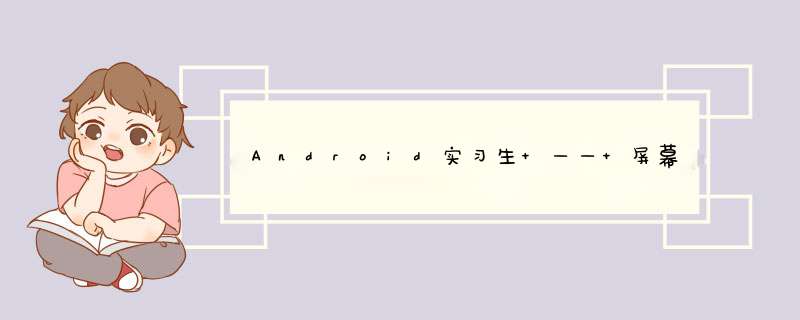
为什么要进行屏幕适配、对哪些设备进行适配?
在近几年的发展当中,安卓设备数量逐渐增长,由于安卓设备的开放性,导致安卓设备的屏幕尺寸大小碎片化极为严重。
从【友盟+】2016年手机生态发展报告H1 中看截止16年手机分辨率使用情况:AndroID设备720p和1080p是主流,如果对前5中AndroID设备分辨率进行适配就能让app在90%的安卓设备上比较美观的兼容。
【屏幕尺寸】:屏幕对角线长度。单位是英寸,1英寸=2.54厘米。
【屏幕分辨率】:屏幕横纵向上的像素点数。单位是px,1px=1像素点。
【像素密度】:屏幕每英寸上的像素点数,单位是dpi,即dot per inch缩写。
【关系及总结】:屏幕同尺寸分辨率越高(像素点越多),像素密度越大,显示效果越好。
像素密度=横向像素点数^2+纵向像素点数^2然后开方取得值,除以屏幕尺寸。
【举例】:【Nexus 5 :4.95英寸、1920*1080、445dpi】
445dpi=(√(1080^2+1920^2))px/4.95 inch
【dpi】:屏幕每英寸上的像素点数,单位是dpi,即dot per inch缩写。
【px】:像素,构成图像的最小单位。(进行ui设计、官方原生API返回的数值都是以px作为计量单位的,比如获取屏幕的宽和高。)
【dp、dip】:密度无关像素。即Density Independent Pixels缩写。(dp等同于dip,以160dpi为基准,1dp=1px。dp意义在于:你可以根据看到的实际大小,在应用中设置对应的dp值,而使得不同的设备上看起来一样大。)
【sp】:即Scale-Independent Pixels。可以根据文字大小首选项进行缩放。推荐使用12sp以上大小的文字;推荐使用12sp、14sp、18sp、22sp;字体大小不要使用奇数和小数,在字体放缩的时候可能导致精度的丢失。
【举例】:
不同的设备上实现非常好的显示效果,因此有多种像素密,主流的5种像素:mdpi、hdpi、xhdpi、xxhdpi、xxxhdpi,以2:3:4:6:8的比例缩放,可修饰drawable和values。
AndroIDManifest.xml设置在中Menifest中添加子元素androID:anyDensity=”true”时,应用程序安装在不同密度的终端上时,程序会分别加载xxhdpi、xhdpi、hdpi、mdpi、ldpi文件夹中的资源。相反,如果设为false,即使在文件夹下拥有相同资源,应用不会自动地去相应文件夹下寻找资源。
在设置控件长宽的时候一般有三种方案:
1.直接用dp属性将控件写死。
2.wrap_content内容自适应。
3.match_parent填充父布局。
以下如图为使用wrap_content、match_parent、weight属性实现的小例子:
用weight属性将tittle栏中间控件进行拉伸适配,左右控件大小不变。
123456789101112131415161718192021 | <linearLayout androID:layout_wIDth="match_parent" androID:layout_height="wrap_content" androID:orIEntation="horizontal"> <button androID:layout_wIDth="wrap_content" androID:layout_height="wrap_content" androID:text="左侧控件" /> <TextVIEw androID:layout_weight="1" androID:layout_wIDth="wrap_content" androID:layout_height="wrap_content" androID:text="Hello World!" androID:textSize="25sp" androID:background="#f5f5f5"/> <button androID:layout_wIDth="wrap_content" androID:layout_height="wrap_content" androID:text="右侧控件 右侧控件" /> </linearLayout> |
[weight属性扩展]
将一排所有控件都加上权重比例时,此时可以将宽度 wrap_content 改为0dp
12345678910111213141516 | <linearLayout androID:layout_wIDth="match_parent" androID:layout_height="wrap_content" androID:orIEntation="horizontal"> <button androID:layout_weight="1" androID:layout_wIDth="0dp" androID:layout_height="wrap_content" androID:text="左侧控件" /> <button androID:layout_weight="2" androID:layout_wIDth="0dp" androID:layout_height="wrap_content" androID:text="右侧控件" /></linearLayout> |
若将layout_wIDth属性设为match_parent的话,比例将会颠倒。
[原因]
weight等式为:
weight计算出的宽度=原来的宽度+屏幕剩余控件宽度所占的百分比
[解释]
假设屏幕宽度为L
则左侧控件宽度=L(match_parent)+[L-2L(两个控件总宽)]1/3=2/3L
同理右侧控件宽度=L(match_parent)+[L-2L(两个控件总宽)]2/3=1/3L
为了证明等式成立,将宽度改为0dp再算一次
则左侧控件宽度=0dp+[L-0-0]1/3=1/3L
则左侧控件宽度=0dp+[L-0-0]2/3=2/3L
绝对布局以一坐标的方式来定位在屏幕上的位置,此布局难维护,一旦屏幕分辨率发生变化,
由于相对位置绝对性,控件将不会自动适配宽高,如图。
线性布局优势可以用weight去适配屏幕的比例大小,但是一些比较复杂的布局,线性布局使用起来就比较麻烦,
这个时候我们可以使用相对布局来适配优化,如图为官方demo,第二排的ok按钮,我们只需要让它紧贴父布局右侧。
Cancel按钮只需位于OK按钮左侧。(若用线性布局去实现,则至少需要两次嵌套。)
1234567891011121314151617181920212223 | <relativeLayout xmlns:androID="http://schemas.androID.com/apk/res/androID" androID:layout_wIDth="match_parent" androID:layout_height="match_parent" > <EditText androID:layout_wIDth="match_parent" androID:layout_height="wrap_content" androID:ID="@+ID/edit" /> <button androID:layout_alignParentRight="true" androID:layout_below="@ID/edit" androID:text="OK" androID:layout_wIDth=" 大专栏 Android实习生 —— 屏幕适配及布局优化;wrap_content" androID:layout_height="wrap_content" androID:ID="@+ID/button2" /> <button androID:layout_toleftOf="@ID/button2" androID:layout_below="@ID/edit" androID:text="CANCEL" androID:layout_wIDth="wrap_content" androID:layout_height="wrap_content" androID:ID="@+ID/button3" /></relativeLayout> |
[使用large限定符]分别创建layout/main.xml,layout-large/main.xml下的不同布局,以适配手机和平板。
12345678910111213141516171819202122232425 | //res/layout/main.xml 单面板<linearLayout xmlns:androID="http://schemas.androID.com/apk/res/androID" androID:orIEntation="vertical" androID:layout_wIDth="match_parent" androID:layout_height="match_parent"> <fragment androID:ID="@+ID/headlines" androID:layout_height="fill_parent" aandroID:layout_wIDth="match_parent" /></linearLayout>//res/layout-large/main.xml 双面板<linearLayout xmlns:androID="http://schemas.androID.com/apk/res/androID" androID:layout_wIDth="fill_parent" androID:layout_height="fill_parent" androID:orIEntation="horizontal"> <fragment androID:ID="@+ID/headlines" androID:layout_height="fill_parent" androID:name="com.bb.headlinesFragment" androID:layout_wIDth="400dp" androID:layout_marginRight="10dp"/> <fragment androID:ID="@+ID/article" androID:layout_height="fill_parent" androID:name="com.bb.ArticleFragment" androID:layout_wIDth="fill_parent" /></linearLayout> |
注意large限定符是在安卓3.2版本以前版本才会起作用的!3.2之后,为了能更精确判断平板范围,谷歌推出了[最小宽度限定符]。
12345678910111213141516171819202122232425 | //res/layout/main.xml,单面板(默认)布局:<linearLayout xmlns:androID="http://schemas.androID.com/apk/res/androID" androID:orIEntation="vertical" androID:layout_wIDth="match_parent" androID:layout_height="match_parent"> <fragment androID:ID="@+ID/headlines" androID:layout_height="fill_parent" androID:name="com.bb.headlinesFragment" androID:layout_wIDth="match_parent" /></linearLayout>//res/layout-sw600dp/main.xml,双面板布局: Small WIDth 最小宽度<linearLayout xmlns:androID="http://schemas.androID.com/apk/res/androID" androID:layout_wIDth="fill_parent" androID:layout_height="fill_parent" androID:orIEntation="horizontal"> <fragment androID:ID="@+ID/headlines" androID:layout_height="fill_parent" androID:name="com.bb.headlinesFragment" androID:layout_wIDth="400dp" androID:layout_marginRight="10dp"/> <fragment androID:ID="@+ID/article" androID:layout_height="fill_parent" androID:name="com.bb.ArticleFragment" androID:layout_wIDth="fill_parent" /></linearLayout> |
通过以上,想要兼容安卓3.2之前的平板设备,需要设置添加这三种lyout。
res/layout/main.xml: 单面板布局
res/layout-large/main.xml: 多面板布局
res/layout-sw600dp/main.xml: 多面板布局
这样维护起来比较困难,如改变large面板布局,还要去更改sw600dp 面板。
我们引入[布局别名]:将多面板相同的地方抽取出来设为main_twopanes进行统一的管理。
res/layout/main.xml 单面板布局
res/layout/main_twopanes.xml 双面板布局
所以我们这么来 *** 作。
12345678910111213141516 | setContentVIEw(R.layout.custom-main);默认布局res/values/layout.xml:<resources><item name="custom-main" type="layout">@layout/main</item></resources>AndroID3.2之前的平板布局res/values-large/layout.xml:<resources><item name="custom-main" type="layout">@layout/main_twopanes</item></resources>AndroID3.2之后的平板布局res/values-sw600dp/layout.xml:<resources><item name="custom-main" type="layout">@layout/main_twopanes</item></resources> |
1234567891011 | 最后一种限定符:[方向限定符]//平板横向res/values-sw600dp-land/layouts.xml:<resources><item name="custom-main" type="layout">@layout/main_twopanes</item></resources>//平板竖直res/values-sw600dp-port/layouts.xml:<resources><item name="custom-main" type="layout">@layout/main</item></resources> |
在AndroID的设计过程中,为了适配不同的手机分辨率,图片大多需要拉伸或者压缩,这样就出现了可以
任意调整大小的一种图片格式“.9.png”。这种图片是用于AndroID开发的一种特殊的图片格式,它的好处
在于可以用简单的方式把一张图片中哪些区域可以拉伸,哪些区域不可以拉伸设定好,同时可以把显示内容
区域的位置标示清楚。
我们可以明显看到.9.png的外围是有一些黑色的线条的1、2、3、4,它们的作用及说明:
序号1和2标识了可以拉伸的区域。(如图只可拉伸标记的一个像素点。)
序号3和4标识了内容区域。
总结整理作者:汪博
个人名言:少壮不努力,老大徒悲伤。
以上是内存溢出为你收集整理的Android实习生 —— 屏幕适配及布局优化全部内容,希望文章能够帮你解决Android实习生 —— 屏幕适配及布局优化所遇到的程序开发问题。
如果觉得内存溢出网站内容还不错,欢迎将内存溢出网站推荐给程序员好友。
欢迎分享,转载请注明来源:内存溢出

 微信扫一扫
微信扫一扫
 支付宝扫一扫
支付宝扫一扫
评论列表(0条)